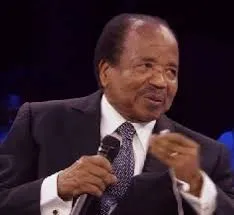On Saturday, November 6, 2021, Paul Biya clocked exactly 39 years as President of the Republic of Cameroon.
While celebrations took place nationwide in his absence, militants of his ruling Cameroon People’s Democratic Movement (CPDM) took turns to re-echo calls for his to run for office in 2025 when his current mandate expires.
After Lekie Division, the entire North West CPDM begged 88-year-old Paul Biya to present himself as presidential candidate in 2025. In 2025, Biya will be over 92 years old. If he renews his mandate, then it will end when he will be 99.
But asking a man who can barely walk to run for office is standing logic on its head. The CPDM should just give Biya wings to fly.
While attending the 2nd Edition of the Paris Peace Summit in November 2019, Biya was seen wobbling as he moved to shake hands with the 43-year-old French leader. His legs were apparently unable to support his weight as he would be supported up a 7-step stairway by his bodyguard.
President Paul Biya will be 89 on February 13, 2022. The current 7-year mandate which he renewed last October 7, 2018, following controversial polls expires in 2025. Before luck shone on him, Biya was Prime Minister for seven uninterrupted years.
Critics say he has in 39 years taken the country to an all-time low, with uncountable crises plaguing the underdeveloped nation, the most pressing of which is the conflict in the North West and South West Regions.
It is even rumoured in some quarters that the hitherto “traveling president” is now being moved around by his wife, Chantal and her puppet, Ferdinand Ngoh Ngoh who is the all-powerful Minister of State, Secretary-General at the Presidency of the Republic. Jeune Afrique once refereed to Ngoh Ngoh as Mr. Vice President.
Will Biya stay on after 2025 or handover power?
As age takes its toll on President Biya, the question about another mandate is being blurred by the succession debate, which, so far, has no clear answer. It is understandable that the President of the Senate takes over in case of a vacancy, but just very briefly to organise an election.
Behind the scenes, CPDM gurus are concerned that without a strong candidate being groomed within their party, power may slip off their hands in 2025, given that the incumbent is gradually fading out of public presence.
If the first three decades of President Paul Biya in power were relatively supported by international financial spheres and owe a lot to the policies of his predecessor, Ahmadou Ahidjo, in recent years, the regime has been riddled with strikes, corruption, hate speech, and bloody conflicts in the North West, South West and Far North regions.
There is also the internal wrangling within the party as observed nationwide during the recent reorganisation of the party’s basic organs. Of course, it does not augur well within the seraglio of Paul Biya, as the question keeps coming back: Is the Biya era definitely over in Cameroon?
To explain the Biya sphinx requires a look back to November 4, 1982. Then aged 58, the first President, Ahmadou Ahidjo, announced his resignation for “health reasons”. He handed over to his constitutional successor, Paul Biya, amidst hypotheses on the reasons for this unexpected resignation.
But the way the former president was treated since his departure from power, the reasons for his departure were quickly found: The internal war within the ruling party, the Cameroonian National Union, CNU, had indeed been brutal. He lost control of the party after five months and Biya transformed it into CPDM in Bamenda.
Ahidjo later denounced a “medical coup d’etat” orchestrated by France and sought, in vain, the assistance of the United States to regain power through a military coup that failed. That was in April 1984. He was sentenced to death in absentia, then pardoned before he died of heart attack, in 1989, in exile in Senegal.
As soon as he took power in 1982, Paul Biya directly subscribed to the economic structuring plan imposed by the International Monetary Fund, IMF. Extensive privatisation and the dismantling of the state economy then took place during the 1980s and 1990s.
The beginning of the 1990s was, nonetheless, a glimmer of hope for Cameroonians with the promised rigour and moralisation. The country experienced its first relatively free elections, in March 1992; even if they were far from transparent. Paul Biya’s rival, John Fru Ndi, finished second in the 1992 presidential election, just four points behind the incumbent. The opponent, who claimed his “victory was stolen”, was then placed under house arrest.
Other presidential elections that followed-in 1997 and 2004-were “farces”, according to the opposition. Paul Biya won these parodies of elections with 92% and 71% of the vote respectively. With a weak multiparty system and increasingly obvious French support for the Unity Palace tenant, power in Cameroon is controlled by the Biya machine.
Paul Biya’s fifth term then planted the seeds of discord, which explains the current situation in the country. It all started with the constitutional revision, between 2007 and 2008. It was followed by some CPDM officials gunning to succeed Biya at the 2011.
They had formed the Group of 11, many members of who are now in prison for embezzlement, though some continue to claim it is because they had expressed interest in Biya’s job.
Cameroon was then plunged into an unprecedented economic crisis. There were waves of protests with repressions rocking the country. It was not until 2015 and 2016 that the protest against the Biya regime was reborn with the Anglophone conflict taking a bloody turn.
As President Biya celebrates 39 years in office, the regime is weakened by numerous scandals and conflicts. He is isolated as he is hardly seen in public or international conferences by his peers. Some of his powers have been delegated to the Secretary General at the Presidency. It is a very dark image of feverish power on the way out. Already, many are questioning what his legacy will be, when he bows out, even if not anytime soon. As the question continues to linger around, political analysts are advancing that it would be nothing but a sphinx of sort.



